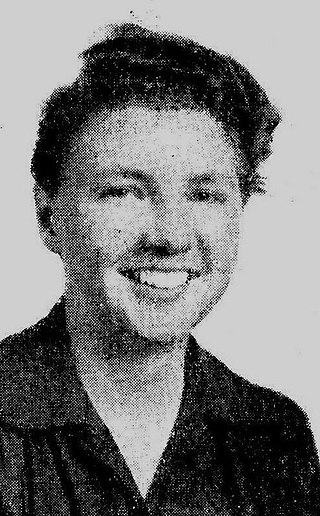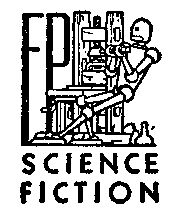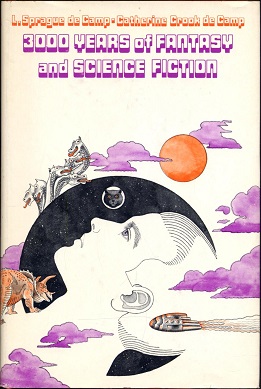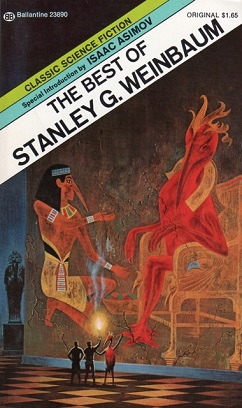
Mars, the fourth planet from the Sun, has appeared as a setting in works of fiction since at least the mid-1600s. Trends in the planet's portrayal have largely been influenced by advances in planetary science. It became the most popular celestial object in fiction in the late 1800s when it became clear that there was no life on the Moon. The predominant genre depicting Mars at the time was utopian fiction. Around the same time, the mistaken belief that there are canals on Mars emerged and made its way into fiction, popularized by Percival Lowell's speculations of an ancient civilization having constructed them. The War of the Worlds, H. G. Wells' story of an alien invasion of Earth by sinister Martians, was published in 1897 and went on to have a large influence on the science fiction genre.

Leigh Douglass Brackett was an American science fiction writer known as "the Queen of Space Opera." She was also a screenwriter, known for The Big Sleep (1946), Rio Bravo (1959), and The Long Goodbye (1973). She also worked on an early draft of The Empire Strikes Back (1980), elements of which remained in the film; she died before it went into production. In 1956, her book The Long Tomorrow made her the first woman ever shortlisted for the Hugo Award for Best Novel, and, along with C. L. Moore, one of the first two women ever nominated for a Hugo Award. In 2020, she won a Retro Hugo for her novel The Nemesis From Terra, originally published as "Shadow Over Mars".

Stanley Grauman Weinbaum was an American science fiction writer. His first story, "A Martian Odyssey", was published to great acclaim in July 1934; the alien Tweel was arguably the first character to satisfy John W. Campbell's challenge: "Write me a creature who thinks as well as a man, or better than a man, but not like a man." Weinbaum wrote more short stories and a few novels, but died from lung cancer less than a year and a half later.

An extraterrestrial or alien is any extraterrestrial lifeform; a lifeform that did not originate on Earth. The word extraterrestrial means "outside Earth". The first published use of extraterrestrial as a noun occurred in 1956, during the Golden Age of Science Fiction.

Jupiter, the largest planet in the Solar System, has appeared in works of fiction across several centuries. The way the planet has been depicted has evolved as more has become known about its composition; it was initially portrayed as being entirely solid, later as having a high-pressure atmosphere with a solid surface underneath, and finally as being entirely gaseous. It was a popular setting during the pulp era of science fiction. Life on the planet has variously been depicted as identical to humans, larger versions of humans, and non-human. Non-human life on Jupiter has been portrayed as primitive in some works and more advanced than humans in others.

Uranus has been used as a setting in works of fiction since shortly after its 1781 discovery, albeit infrequently. The earliest depictions portrayed it as having a solid surface, whereas later stories portrayed it more accurately as a gaseous planet. Its moons have also appeared in a handful of works. Both the planet and its moons have experienced a slight trend of increased representation in fiction over time.

The Black Flame is a post-apocalyptic science fiction novel by American writer Stanley G. Weinbaum, originally published in hardcover by Fantasy Press in 1948.

"A Martian Odyssey" is a science fiction short story by American writer Stanley G. Weinbaum originally published in the July 1934 issue of Wonder Stories. It was Weinbaum's second published story, and remains his best known. It was followed four months later by a sequel, "Valley of Dreams". These are the only stories by Weinbaum set on Mars.
"Valley of Dreams" is a science fiction short story by the American writer Stanley G. Weinbaum, originally published in the November 1934 issue of Wonder Stories. It was Weinbaum's second published story and is a sequel to his first story, "A Martian Odyssey".
"Parasite Planet" is a science fiction short story by American writer Stanley G. Weinbaum originally published in the February 1935 issue of Astounding Stories. It was Weinbaum's fourth published story, and the first to be set on Venus. He quickly followed it up with a sequel called "The Lotus Eaters".
"The Planet of Doubt" is a science fiction short story by American writer Stanley G. Weinbaum that was first published in the October 1935 issue of Astounding Stories. It is Weinbaum's third story featuring Hamilton Hammond and Patricia Burlingame, a sequel to "Parasite Planet" and "The Lotus Eaters".
"The Lotus Eaters" is a science fiction short story by American writer Stanley G. Weinbaum originally published in the April 1935 issue of Astounding Stories. "The Lotus Eaters" was Weinbaum's fifth published story, and is a sequel to "Parasite Planet".
"The Mad Moon" is a science fiction short story by American writer Stanley G. Weinbaum, first published in the December 1935 issue of Astounding Stories. As did his earlier stories "A Martian Odyssey" and "Parasite Planet", "The Mad Moon" emphasizes Weinbaum's alien ecologies. "The Mad Moon" was the only Weinbaum story set on Io.

Fantasy Press was an American publishing house specialising in fantasy and science fiction titles. Established in 1946 by Lloyd Arthur Eshbach in Reading, Pennsylvania, it was most notable for publishing the works of authors such as Robert A. Heinlein and E. E. Smith. One of its more notable offerings was the Lensman series.
Tweel is a fictional extraterrestrial from the planet Mars, featured in two short stories by Stanley G. Weinbaum. The alien was featured in A Martian Odyssey, first published in 1934, and Valley of Dreams four months later. Weinbaum died of lung cancer soon after, and a third installment in the series never saw fruition. Tweel remains one of the most recognised aliens in early science fiction, and is said to be an inspiration for aliens in the works of Isaac Asimov and Arthur C. Clarke.

3000 Years of Fantasy and Science Fiction is an anthology of fantasy and science fiction short stories, edited by American writers L. Sprague de Camp and Catherine Crook de Camp. It was first published in both hardcover and paperback by Lothrop Lee & Shepard in 1972. It was the first such anthology assembled by the de Camps, preceding their later Tales Beyond Time (1973).

The Collected Stories of Philip K. Dick is a collection of 118 science fiction stories by American writer Philip K. Dick. It was first published by Underwood-Miller in 1987 as a five volume set. See Philip K. Dick bibliography for information about the mass market reprints.

The Red Peri is a collection of science fiction short stories by American writer Stanley G. Weinbaum. It was first published in 1952 by Fantasy Press in an edition of 1,732 copies. The stories originally appeared in the magazines Amazing Stories, Astounding and Thrilling Wonder Stories.
Fantasy Publishing Company, Inc., or FPCI, was an American science fiction and fantasy small press specialty publishing company established in 1946. It was the fourth small press company founded by William L. Crawford.

The Best of Stanley G. Weinbaum is a collection of science fiction stories by Stanley G. Weinbaum, published in 1974 as an original paperback by Ballantine Books as a volume in its Classic Library of Science Fiction. The volume included an introduction by Isaac Asimov and an afterword by Robert Bloch. Ballantine reissued the collection twice in the later 1970s; Garland Publishing published a library hardcover edition in 1983, and Sphere Books released a UK market edition in 1977, under the title A Martian Odyssey and Other Stories. The original edition placed third in the 1975 Locus Poll for best genre collection.












